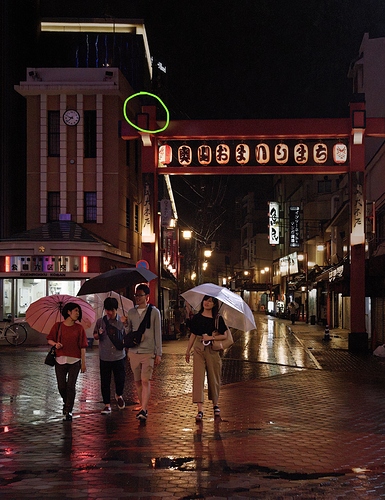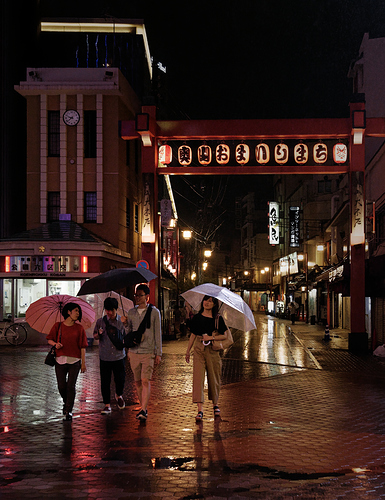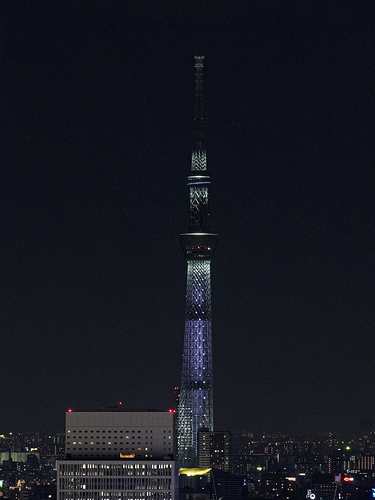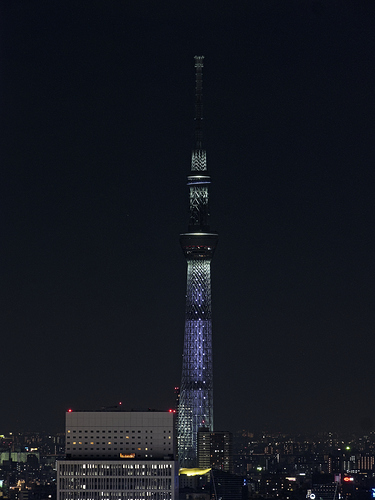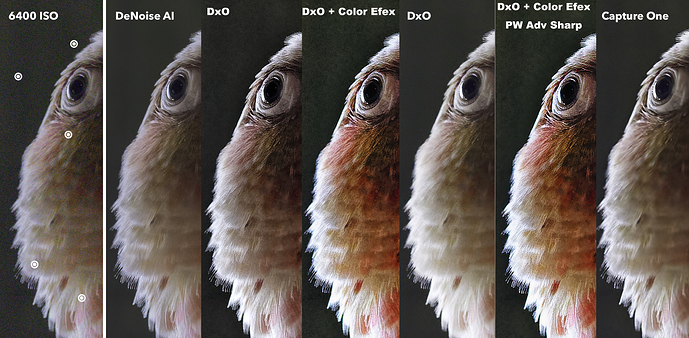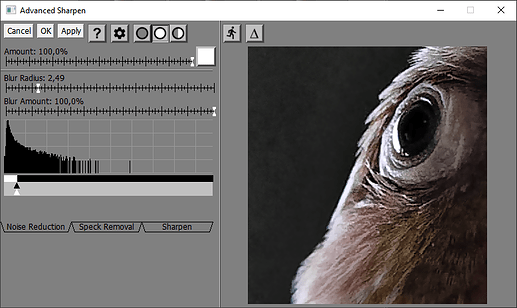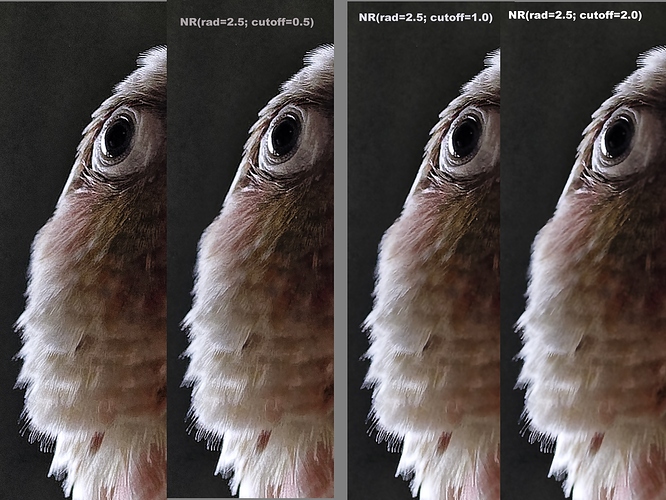Now that is an idea worth voting, do not forget to do so @Madaboutpix 
Topaz Denoise AI is impressive - and as I recall it can apply noise reduction locally, not just globally. While it isn’t perfect or speedy or even easy to use, it can be superior to PRIME in the current release of PhotoLab - not only in extreme cases, but also for smoothing bokeh and avoiding artifacts.
“Using AI” is not an end in itself. What is important is the effectiveness of the algorithm towards results. Beware of marketing here! The true test is to compare signal to noise ratios between resulting images and the truth scene. Different image areas have different noise levels, depending on multiple factors, such as luminance, hue, …
Does a good noise reduction benchmark exist in the public domain which compares PL3 with the competition?
Undisputable home truths, all of them, AFAIC, nor am I easily swayed by marketing bla, Pierre. Wouldn’t even be surprised if the latest iteration of Prime was already utilizing AI to some extent. The point I was trying to make is that that the NR-in-RAW-conversion field has grown more competitive in recent years, notably since the advent of Topaz DeNoise AI, and that DxO should not take for granted that Prime as is will remain class-leading forever, without further evolution.
You might be interested in this article comparing noise removal.
The original CR2 raw file is available for download.
Have you found that PL3 falls behind competing products, as shown using this particular test image file ?
Very interesting article.
My main complaint is that the author also did some other adjustments prior noise reduction, e.g. tone curve in the case of DxO. You can clearly see that the DxO processed image is brighter. Lens corrections were also applied.
I think it would have been better for comparability’s sake if she would have just tested the noise reduction without any other corrections. Also, 44% luminance may be a little high for my liking, and I rarely apply additional sharpness when already having the automatic lens sharpness switched on. In addition, value of 48% for chrominance seems too low, I checked with her original RAW file and there is plenty of colour noise left in the background which is by the way not just one colour or structureless but has some detail in it. By the way, why did she use a TIFF for working with Topaz? Everything is not very consistent.
HOWEVER, I have to agree that there are a couple of artifacts in the perimeter of the bird and a certain blockiness in comparison to TopazDeNoise is clearly noticeable. Topaz seems to render the image overall cleaner. But let‘s not forget that the zoom level is around 240%.
Otherwise, Topaz seems to lose detail in uniformly coloured areas if low light mode is used. Standard mode is not an option for night time images in my opinion. See for comparison the two following images, especially in the green circled area an in the black umbrella guy‘s grey jacket.
Topaz settings (first image): Low light mode enabled, Remove Noise 15, Sharpen 38, Recover Original Detail 100, Colour Noise Reduction 0
DxO settings: PRIME, Luminance 15 (my standard), Chrominance 50, Low Frequency 75, other settings 0.
Again, the DxO processed image seems to be quite tangling, especially in bigger uniformely coloured areas.
So, if PRIME is only 2nd best noise reduction, well… I really don‘t care that much. It is still one of the best. But I have to agree that people at DxO should not rest on their laurels but keep improvements going since there are still things to improve, e.g. look here.
The blockiness thing in addition is for sure a thing to keep working on.
Just wanted to add something. DxO deals with difficult images better. I was in Tokyo a long time ago (it seems) and I once had forgotten to switch on the long time exposure denoise feature on my Lumix G9  So in the end images with lots of sensor noise and hot pixels. Topaz leaves something to be desired since a lot of noise is left after the AI treatment. I think with DxO you have more options to deal with such situations better.
So in the end images with lots of sensor noise and hot pixels. Topaz leaves something to be desired since a lot of noise is left after the AI treatment. I think with DxO you have more options to deal with such situations better.
Original image
Topaz
DxOPrime
This function is only ooc-jpeg or not?
I remember my g80 has some features which help out in night exposed images.
But asci recal correctly it’s only jpeg not rw2.
I did some testing in dxo prime 40% and tiff with dfine2 and dxo prime 70%
That’s about equal.
What about the comparison: Prime is a few years old now ,as in no big step forward only finetuning, so it’s normal other applications are catching up. And i am sure DxO knows this.
I find it stil a great feature in combination with the optical module.
The artefacts are sometimes visible at 100% when prime is used at detailed images.
And plane colors can be smoothend to plastic looks when you over agressive in denoising.
I use often a temp export to look at a jpeg which is easier then moving that preview window around.
No, Peter, the long time noise reduction works for RAW as well, it is not limited to JPEG, as it is mentioned in several Lumix forums and e.g. in a book covering the Lumix G9 that I own. I also can see clear differences in long time exposure having this option switched on and off when exclusively working with RAW format.
The author of the article makes it clear he had previous personal experience using Topaz Denoise AI as well as a professional relationship with Topaz before embarking on this comparison with other products, As a result we need to eliminate him as a completely objective tester and observer. Second, it is clear that he is relatively unfamiliar with the PhotoLab tool set. We have no idea what settings were used for PRIME or whether the visible artifacts are related to other adjustments. In other words this is not a really good comparison.
I own Topaz Denoise AI. It is an excellent tool, but my experience is that when comparing it to PRIME the results seem to vary significantly from image to image. On some images Topaz gives clearly superior results. However, much of the time I get similar results from both and often the results from PRIME are superior to Topaz. Unlike PRIME, Topaz Denoise can also be used on jpegs, which is the main reason I acquired it.
WhileTopaz can also be used directly on raw images I don’t find it particularly useful to do that. You have to save the output in a different format before applying additional edits in other software. That eliminates most of the usefulness of shooting raw. PhotoLab is a much more elegant solution. You can apply your edits directly to your raw files and export them with PRIME.
Mark
I looked in the printed g80 usermanual page 200 of g80.
And i found a manual written text of my hand, “also posible in raw modes” same as shadow compensation, which seems also active in my raw plus jpeg modes i mostly use.
Which i come to think about.
I had some overshooting vignetting, brighter corners, shooting in the sky with a 14-140mm f3.5-5.6 maybe the compensation did that. DXO calibrated the lens module after my examples. 
And i had some issues in redisch glow in night shot’s would the long shutter noise reduction be a factor of this? Due the noicereduction system. I read it takes a second image with the shutter closed. To distract this value of the earlier shot.
Those where only raw not oocjpeg.
Hello Mark,
I can see your point but wouldn’t be that harsh. You can clearly see her settings in one of the images posted in the article. But I agree that one could have easily optimized the settings if one knew the software better.
These artifacts mentioned are common for DxO as was stated not only by me but by other forum readers. However, I have to agree that DxO’s combined solution is to be preferred in my opinion. From my short time with Topaz Denoise AI I can say that at first sight results are quite as impressive as DxO’s PRIME, but there seems to be a bigger emphasis on a clear picture than preserving detail which is clearly the goal of DxO’s method. In addition, Topaz doesn’t deal well with hot pixels due to long time exposure. Although I have to tell you that I like the Topaz rendering of uniformely coloured areas slightly better. DxO is sometimes a little bit too restless for my liking.
Don’t get me wrong, I will stay with DxO and its PRIME methode since it was the reason for switching from Lightroom (and the stupid abo model) in the first place as the software was recommended by my brother years ago, but there is still (and of course always will be) room for improvements.
I completely agree with you. I certainly saw the value of owning Topaz as well as PhotoLab. While I don’t use Topaz often, I occasionally find it very useful.
When comparing PRIME to Topaz I believe it is difficult to say which one is consistently more effective. In my experience It depends on the image used and on the NR adjustments applied to it. I think I can safely state that DXO PRIME and Topaz Denoise AI are by far the best two noise reduction applications currently available to consumers.
Mark
When people are hopping from application to application , multistage development, then a good tiff/jpeg denoise application is worth it to have. Because sharpening is done at the end mostly which is the the counterpart of denoising.
For people who are mostly stick to one for raw to end result DxO is quite good. And for the incidence of a multistage development , Nik Collection free stil has Define2.
You might be interested in this article comparing noise removal.
Oh, thanks. While I will readily admit that Fstoppers is probably not the first address where I would look for even semi-scientific rigour, this is still highly appreciated. Hillary Fox, the author of the comparison, found Topaz DeNoise AI the most effective of the solutions she tested, with DxO PL’s Prime yielding the second best, though “a bit tricky” to work with, given the limited preview. However, her settings before export don’t strike me as particularly judicious and based on deep experience with the product. To begin with, she would have likely got better results if she had started out with the “magic wand” defaults and further adjusted from there, instead of bumping up the Low freq. all the way to 100. Likewise, her decisions regarding Lens sharpness and Unsharp mask may not be the best, and by applying the Natural preset and a dedicated camera colour profile for her Canon 6D, she might well have started out with a considerably cleaner image even before fine-tuning the NR.
The original CR2 raw file is available for download.
Have you found that PL3 falls behind competing products, as shown using this particular test image file ?
Er, I was reluctant to sign up with DropBox, and so I didn’t download and play around with the RAW file. Also, the only comparison I could do would be with Pentax’s proprietary RAW converter Digital Camera Utility 5, which would probably be of little interest to most users here.
Great imput and comparisons in both of your posts, MaxReebo. Really appreciated.
Have you considered voting up the feature request, even if mainly to keep DxO developers on their toes about the NR competition out there?
Here is my attempt to denoise the same image as published in the Fstoppers article mentioned above.
I have been using Photolab since June (about 2 months).
I overlaid my results over the author’s final comparison of the various products
From left to right:
- Author’s 6400 ISO image
- Author’s DenoiseAI
- My DxO version
PRIME Luminance 40 Chrominance 100;
Optics Sharpening Global 3.0 Details 100 - My DxO version (#3), processed by Nik Color Efex
- Author’s DxO version
- My DxO/Nik ColorEfex version (#4), processed by Picture Window Advanced Sharpening
Noise Reduction
Speck removal
Sharpening - Author’s Capture One
In my assessment, the Author’s version of Denoise AI removed much of the eye’s texture, does not reveal any punch in the feather colors, and the feathers lack details in the shadows.
Noise-Reduction-Challenge-Software-Comparison.tif (15.3 MB)
Quite intriguing, your comparison with your own efforts of applying Prime to the author’s image in various combinations, Pierre. Overall, however, I still find the DeNoise AI result admirably clean yet rich in subtle detail. To be sure, you have unlocked even more detail and achieved more crispness, but this comes at the price of a certain blotchiness or grittiness. Whether this could be fixed by spending even more time with the file in PL or the Nik Collection, I don’t know.
At any rate, there still seems to be room for improvement with Prime, particularly given the ease and speed with which the Topaz result seems to have been obtained.
If one prefers smoothing the image at the expense of details, then additional noise reduction is easy to apply in Picture Window Pro, “free for personal or commercial use”. The results come close to the Topaz AI results.
Starting with Photolab’s PRIME resullts presented earlier, I experimented with PWP’s noise reduction tool embedded in the advanced sharpening transformation.
In the noise reduction tab, adjust the desired blurring radius and the spatial frequency range where to apply the blurring. This transformation is very poweful; it also includes despecking and sharpening – both of which I have not enabled for this experiment.
